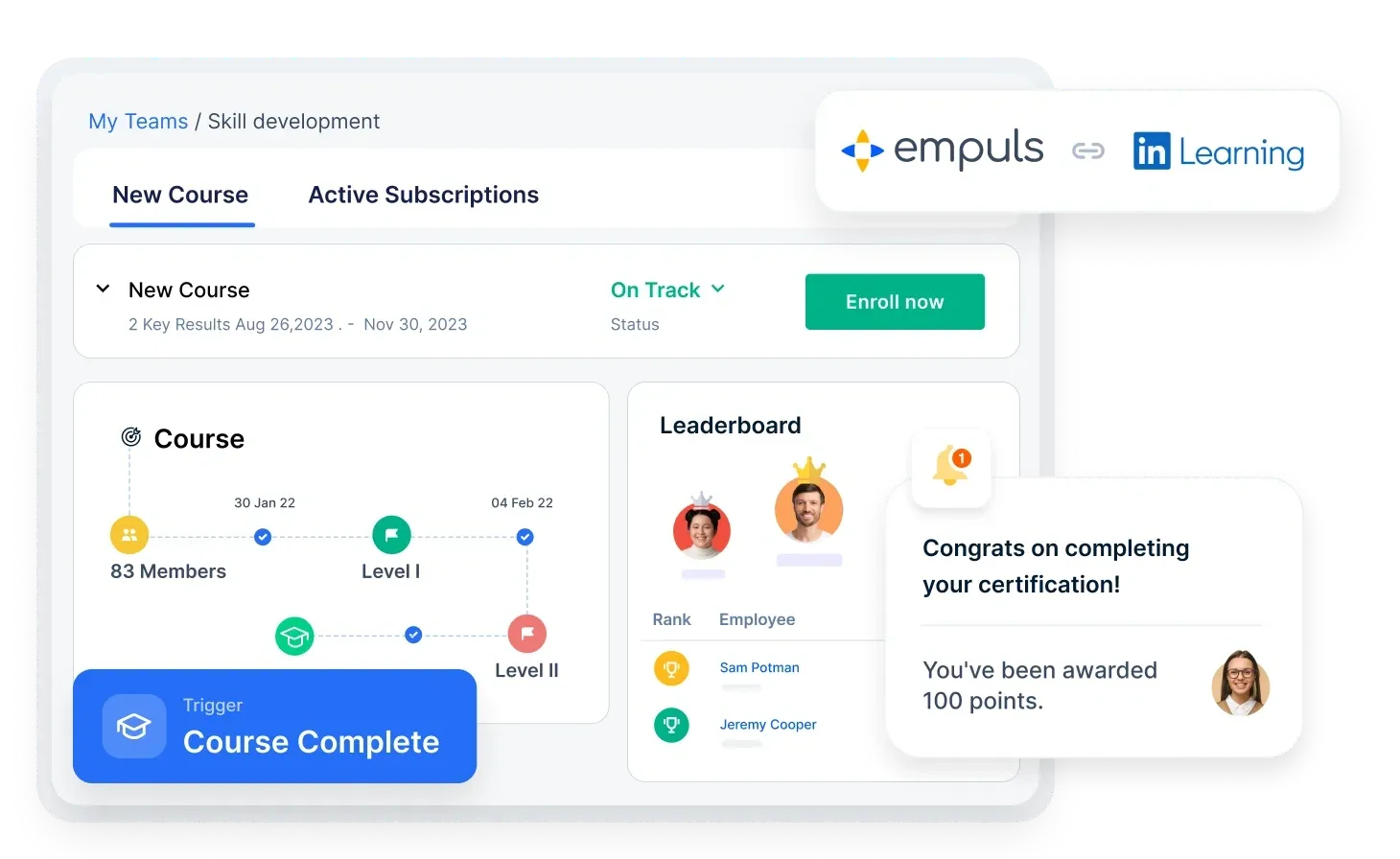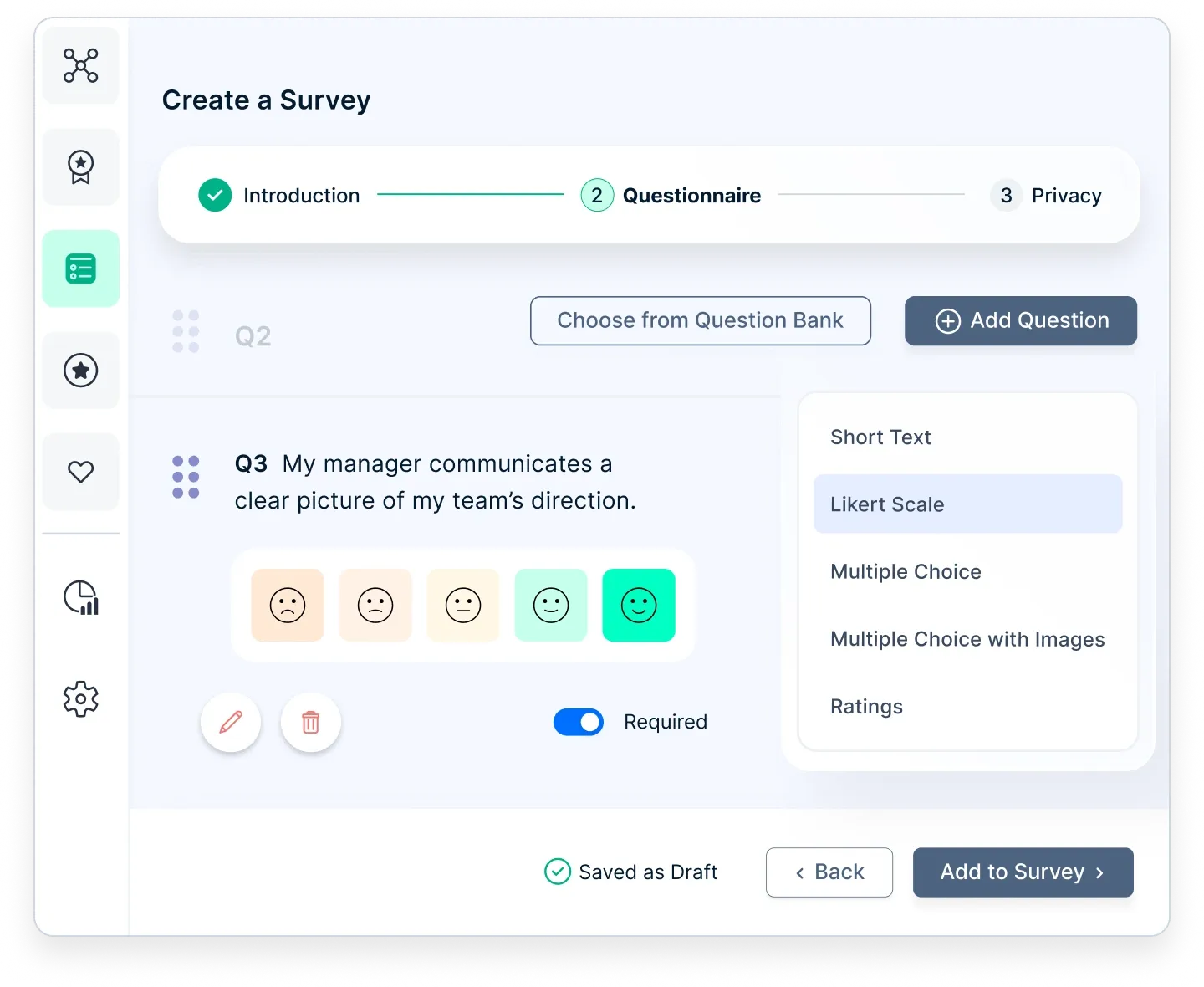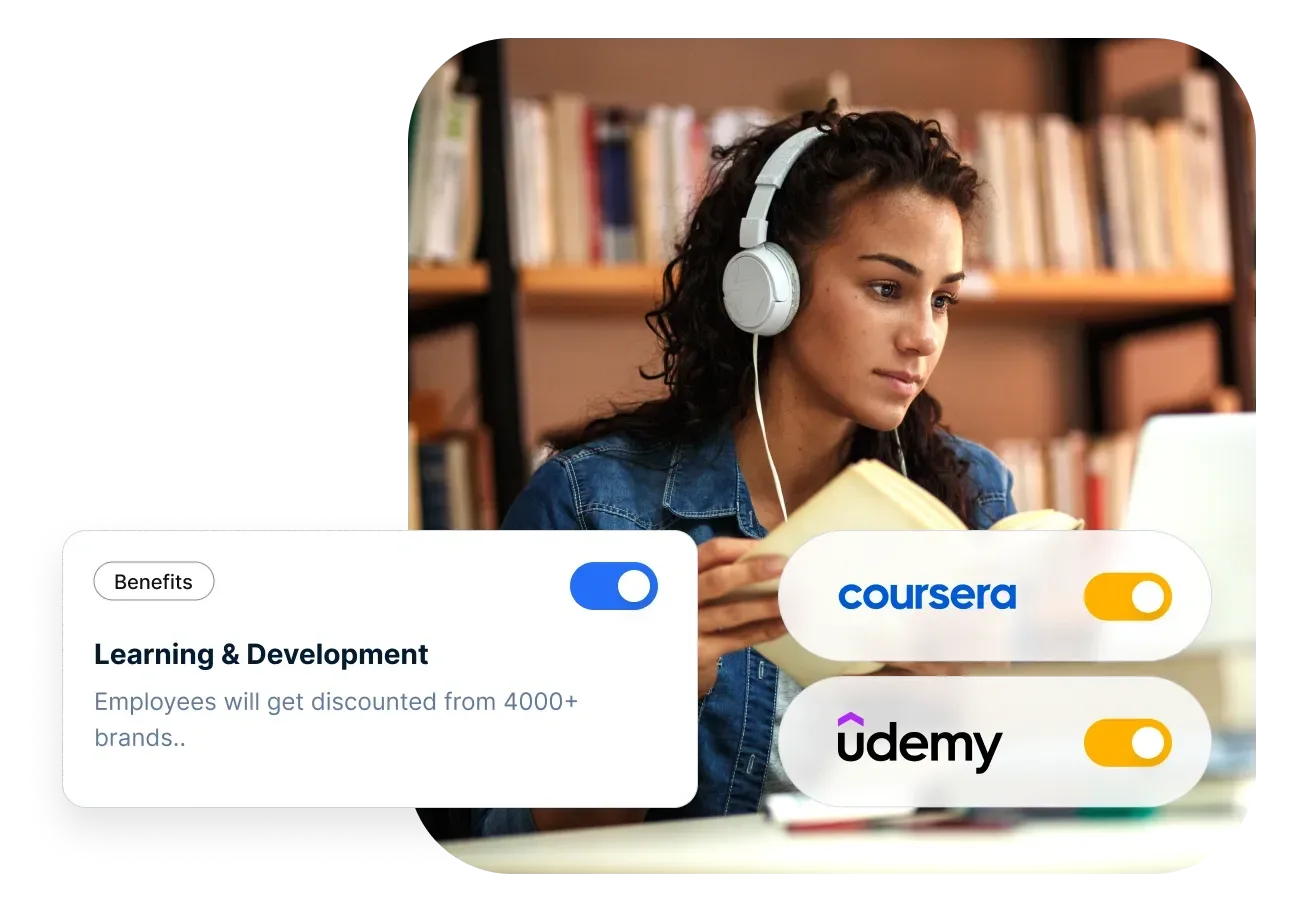Employee Development Plan & Strategies for Workplace Growth
A strong employee development plan backed by the right employee development strategies helps businesses nurture talent, boost retention, and improve productivity. Discover how to create a growth-driven workplace where employees thrive and contribute to long-term success.
On this page
To attract, retain, and develop top talent, companies must invest in a strategic employee development plan that aligns with employees' career aspirations. A well-structured plan not only enhances employee development strategies but also boosts engagement, productivity, and retention.
Think about the people who shaped your career—teachers, mentors, or leaders who recognized your potential. Development plans for employees serve the same purpose, providing learning opportunities that help them grow professionally and stay motivated. In fact, Gallup research shows that career growth opportunities are the top reason employees switch jobs.
An effective employee growth plan leads to better performance, stronger workplace culture, and long-term success. Research also highlights that organizations investing in employee development strategies see 11% greater profitability and are twice as likely to retain their workforce.
This article explores how to create an employee development plan, its key components, and best practices to help organizations build a workplace where employees thrive.
"Train people well enough so they can leave. Treat them well enough so they don’t want to." – Sir Richard Branson
What is an employee development plan?
An employee development plan is a structured approach to training and development, educating, and enabling employees to improve their professional capabilities and value within the organization.
The organizations implement such employee engagement and development programs to align with organizational goals and with employees' professional goals. Employee development programs, when done right, have proven to be great means of attracting and retaining the best talent.
Employees who are constantly learning about their jobs are more engaged and productive. However, a cookie-cutter approach to employee development planning – where you apply the same ideas to all employees, will not be effective.
Let's delve into the fundamental principles of building an employee development plan and the best ways for you to adapt them to your organization. But first, let's look into why it's worthwhile to spend time and effort on an employee development plan.
Why your company needs a strong employee development program
Companies invest in employee development for various reasons, ranging from career advancement to enhancing job satisfaction. These programs address several critical aspects:
- Enhancing and updating employees' skills to align with evolving job requirements.
- Nurturing leadership qualities and managerial skills among employees.
- Adapting to technological advancements and expanding skill sets accordingly.
- Building confidence and readiness for new challenges and responsibilities.
- Providing support for improved individual and team performance.
- ostering an inclusive environment through programs that promote diversity and equity.
- Enhancing the effectiveness of internship and return ship initiatives.
Employee development and mentorship programs have proven to be valuable for organizations, resulting in higher retention rates and increased engagement levels among participants. Notable examples include:
- The Forum’s Mentoring Program supporting more entrepreneurs through mentorship.
- Caterpillar implemented reverse mentoring to empower junior employees.
- Accenture offers a 16-week paid returnship for individuals re-entering the workforce.
Formal mentoring programs yield significant benefits, as indicated by data:
- 84% of CEOs credit mentors with helping them avoid costly mistakes.
- 86% of CEOs acknowledge mentors as crucial to their career accomplishments.
- 91% of Fortune 500 companies offer workplace mentoring programs.
- 89% of mentees become mentors themselves.
In 2024, mentorship is identified as the top focus area for learning and development.
Employees seek more from their workplaces, including career development, long-term growth, competitive remuneration, and overall well-being.
Employee development programs, particularly mentorship initiatives, serve as practical tools for engaging, retaining, and investing in team members. Embracing these programs positions organizations to meet their workforce's evolving needs and expectations.
Benefits of an employee development plan
Investing in an effective employee engagement and development plan can prove to be a win-win for both employees and the organization.
Here are some key benefits of having an employee development plan:
- It helps attract the best talent in the market.
- It improves employee engagement and motivation.
- It drives employee performance and productivity.
- It improves retention rate and employee satisfaction.
- It improves the profitability and growth of the business.
However, creating an effective employee development plan is easier said than done.
How to build employee development plans?
Here is a five-step approach to creating an effective employee development plan.
1. Assess organizational needs
Understand clearly where you stand as an organization today and where you intend to be. Figure out your objectives, goals, values, and the opportunities and challenges you tackle as an organization. When you know these clearly, you will know what needs to be done to strengthen your workforce to achieve your objectives.
You can collect feedback and suggestions from your leaders and employees to understand. This helps create a priority list – which can guide you to make better decisions.
2. Assess employee goals and needs
Every employee is different, including their strengths, weaknesses, skills, goals, and aspirations. That is why, when you design an employee development plan, it is important to understand what your employees' needs are and where they aspire to be. Again, using a survey tool like Empuls can help you easily collect inputs from employees and derive meaningful insights from it.
3. Create a plan that meets organizational and employee needs
If your development plan focuses only on achieving organizational goals and doesn't consider employee needs, it can leave them actively disengaged and unmotivated.
At the same time, if your development plan focuses only on employee needs, side-lining the organizational goals, it can be called a career development plan and not an employee development plan.
An employee engagement plan should balance and satisfy the agendas of both employees and the organization to maximize profitability and engagement,
4. Choose a suitable medium and tools
Once you design an employee development plan, the next thing is to figure out the right tools, mediums, and resources to make it effective.
Some of the most popular mediums include–mentoring, coaching, cross-training, job rotation, online videos, podcasts, ebooks, e-courses, tuition reimbursements, etc. From trendy to traditional, there are many more ideas for you to explore.
5. Track the results and refine your strategy
Like any other business process, employee development plans should be tested, refined, and optimized over time for the best outcomes. Employee surveys, one-on-one discussions, performance metrics, and feedback can all be ways to track and improve your employee engagement and development plan.
A tool like Empuls can easily help you do all this and more. The outcome of the analysis can improve the effectiveness and adjust the trajectory of the employee development plan.
After following all these steps and best practices, an organization may still face challenges. Let's take a look at what they can be.
Ways to improve an employee development plan
Here are the steps every organization must follow to make their employee development program more effective.
1. Drive your managers to coach their teams and employees
Historically, managers have always been the anchors for learning. Learning about the what, why, when, where, and how organizational working, technology, policies, and general best practices have always been through managers. However, off late, managers are overburdened and have lost the focus on mentoring and coaching.
Organizations need to kindle the enthusiasm in managers through recognition, incentives, and rewards to mentor and coach their teams. They also need to coach the managers to understand the importance and benefits of their team development.
2. Deal with the short-shelf life of learning and development needs
The times when employee development plans used to be relevant for years are behind us. Employee development plans can become obsolete quickly – sometimes in just months.
In today's evolving technology landscape, organizations need to constantly support and meet the growing demands of employee learning and development. They need to relook at their larger objectives and develop new employee development plans from time to time.
3. Encourage employees to own their career development
One-size-fits-all employee development plans that are highly structured are not relevant anymore. Each employee's career path, interests, and goals are different – and so are their learning needs. Organizations need to understand those needs and own, control, and self-direct their learning programs.
However, building employee learning plans that are 'customized' for every individual and cost-effective at scale can be challenging for organizations.
4. Build customized learning programs for your virtual teams
Every organization has a percentage of employees who work virtually – be it the field sales executives, remote professionals, or the gig workforce. These employees often get overlooked or miss out on when developing learning programs.
Just because employees are out of sight doesn't mean they need to be out of mind. For an employee learning plan to be successful, it must cater to the specific learning needs of a hybrid workforce.
5. Offer different learning options to different learning styles
Today's workforce comprises five different generations, including baby boomers, millennials, Gen X, Gen Y, and Gen Z, and each one has different learning preferences.
Organizations should accommodate a variety of learning mediums like online courses, in-room learning, workshops, etc. to cater to the different learning styles, expectations, and preferences of employees.
7 exceptional employee development strategies with examples
Employee development is crucial for fostering a skilled and engaged workforce. Here are seven exceptional employee development programs with examples from companies implementing them.
1. Personalized learning plans
Tailor development plans to individual employees based on their skills, interests, and career goals. Conduct regular assessments to identify strengths and areas for improvement. Provide access to diverse learning resources such as online courses, workshops, and mentorship programs. This approach ensures that employees receive targeted development opportunities that align with their unique needs.
This tailored approach ensures that employees acquire the skills needed for their desired career trajectory while aligning with Salesforce's business objectives.
2. Mentorship and coaching programs
Implement mentorship and coaching initiatives to facilitate knowledge transfer and skill development. Pair less experienced employees with seasoned mentors who can provide guidance, share insights, and offer constructive feedback. Regular one-on-one coaching sessions can address specific challenges, accelerate learning, and contribute to professional growth.
Adobe has a robust mentorship program that pairs employees with mentors who provide guidance on career development, skill enhancement, and personal growth. Mentors and mentees collaborate on defining goals and creating actionable plans.
For instance, if a junior graphic designer at Adobe wishes to advance their skills in user experience (UX) design, the mentorship program might match them with a senior UX designer.
Through regular meetings, the mentee receives personalized advice, feedback on projects, and insights into the industry, fostering professional growth.
3. Reverse mentoring program
A reverse mentoring program is a strategic initiative where younger or less experienced employees' mentor older or more senior colleagues, often in the context of technology, digital skills, or cultural insights.
Unlike traditional mentoring, where senior individuals guide and mentor junior ones, reverse mentoring flips this dynamic, allowing for knowledge exchange in both directions. The primary goal is to foster collaboration, bridge generation gaps, and promote a culture of continuous learning within an organization.
As a response, Heineken initiated a reverse mentoring program in which junior employees take on the role of mentors for senior leaders and executives.
The primary objective of this program is to offer leadership a novel perspective on the future of work and identify areas for growth.
In addition to the reverse mentoring program, Heineken has implemented a global diversity and inclusion initiative. This initiative is designed to empower colleagues to actively practice inclusion and embrace the diverse cultures in the countries where the company operates.
During the program's development, Pascale Thore, Heineken’s Global Diversity Equity and Inclusion Head, conducted 45 introductory interviews to gauge employees' perceptions of the company's inclusivity and to identify measures for improvement.
The ultimate aim was to create a program that addresses the diverse needs of employees across all five layers of Maslow’s Hierarchy of Needs, including considerations for physiology, belonging, self-actualization, self-esteem, and safety.
4. Employee rotation programs
Implement programs that allow employees to rotate through different roles and responsibilities within the organization. This provides them with a holistic understanding of the business, fosters adaptability, and helps identify their strengths and preferences. Employee rotation encourages a diverse skill set and promotes a sense of belonging within the organization.
Google is well-known for its innovative workplace practices, and one of them is the "20% Time" program. This initiative allows employees to spend 20% of their working hours on projects of their choosing, even if those projects are outside their typical job responsibilities.
This program encourages employee rotation across different roles and projects, fostering creativity and skill development. For instance, a software engineer working on search algorithms might use their 20% time to contribute to a user interface design project.
This not only provides employees with a chance to explore different areas within the company but also helps them develop a diverse set of skills. The program has led to the development of some significant products at Google, including Gmail and Google News.
5. Technology-based learning platforms
Leverage technology to provide employees with access to online learning platforms, webinars, and virtual training sessions. This allows for flexible, self-paced learning that accommodates different learning styles and preferences.
Technology-based learning also enables employees to stay updated on industry trends and acquire new skills relevant to their roles.
IBM has a strong commitment to employee development, and one of its key strategies is the "Think Academy." IBM offers a variety of training and development workshops through this platform, covering topics such as technical skills, leadership development, and industry-specific knowledge.
These workshops are often available in various formats, including online courses, in-person workshops, and self-paced modules. By providing employees with access to continuous learning opportunities, IBM ensures that its workforce stays at the forefront of industry trends and maintains a high level of expertise in their respective fields.
6. Employee Resource Groups (ERGs)
Employee Resource Groups (ERGs) are instrumental in fostering a supportive and inclusive workplace environment, contributing significantly to employee development. These groups serve as dynamic platforms that go beyond traditional professional networks, offering a rich array of opportunities for skill enhancement, career advancement, and personal growth.
ERGs provide a space where employees with shared interests, backgrounds, or aspirations can connect, collaborate, and learn from one another.
Through mentorship programs, workshops, and networking events, ERGs empower individuals to develop essential skills, navigate their career paths, and cultivate a sense of belonging within the organization.
By promoting diversity, equity, and inclusion, ERGs not only contribute to the personal and professional development of employees but also enhance the overall organizational culture, fostering innovation and success.
Cisco promotes diversity and inclusion through various Employee Resource Groups (ERGs), and one standout example is the "Connected Women" network. This group provides a platform for women to connect, share experiences, and participate in mentorship programs.
Cisco recognizes that fostering diverse talent is essential for innovation and success.
The "Connected Women" network offers a supportive community and professional development opportunities, including workshops, seminars, and leadership training, empowering women within the company to advance in their careers and contribute to Cisco's overall success.
7. Promote cross-functional collaboration
Breaking down silos and promoting collaboration across different departments or teams fosters a diverse and enriching learning environment. Encourage employees to participate in cross-functional projects, job rotations, or mentorship programs.
Exposure to various aspects of the business not only broadens skill sets but also cultivates a holistic understanding of the organization, contributing to long-term career development.
Empuls: Driving employee development with rewards, feedback, and perks
A well-structured employee development plan goes beyond training—it’s about engaging, motivating, and retaining employees through continuous learning, feedback, and meaningful recognition.
Empuls helps organizations achieve this by integrating learning rewards, surveys, and employee perks into their development strategy, ensuring employees stay invested in their growth.
1. Motivate learning with milestone rewards

Encouraging professional growth is easier when employees have tangible incentives. With Empuls milestone rewards, organizations can reward employees for completing certifications, upskilling courses, or reaching career milestones. This creates a culture of continuous learning while reinforcing positive behaviors.
2. Use surveys to refine development strategies

An effective employee development plan requires continuous feedback. Empuls surveys help HR teams gauge employee sentiment about training programs, leadership effectiveness, and career growth opportunities. Regular pulse surveys ensure that development initiatives remain aligned with employee needs and company goals.
3. Boost engagement with perks and benefits

Learning and growth shouldn’t be limited to formal training. Offering employee perks and fringe benefits—such as wellness programs, flexible work arrangements, and financial incentives—enhances job satisfaction and encourages employees to take charge of their professional journey.
4. Create a holistic development experience

By integrating rewards, feedback, and benefits, Empuls turns employee development into an engaging, ongoing process rather than a one-time initiative. Employees feel valued, motivated, and empowered to reach their full potential—leading to higher retention, productivity, and overall workplace satisfaction.
Organizations that prioritize employee development strategies with Empuls build a workforce that is skilled, engaged, and ready for long-term success.
Conclusion
When you look around your organization, you find different kinds of employees with different skills and capabilities. Imagine how far they can go with an effective employee engagement and development plan.
Creating an employee development plan can connect them with the right resources, opportunities, and people to help them do their best while simultaneously driving organizational goals.















